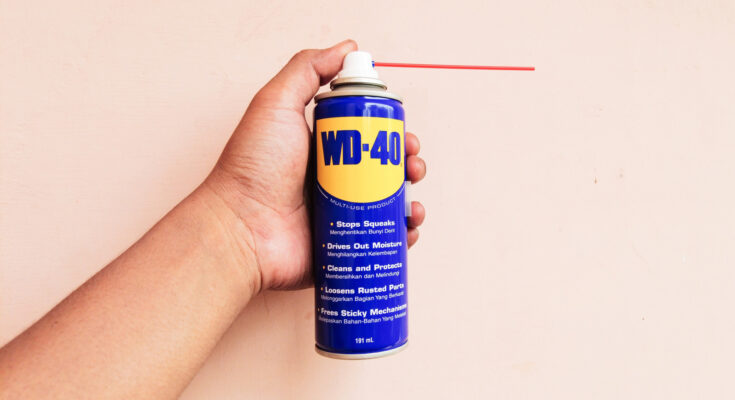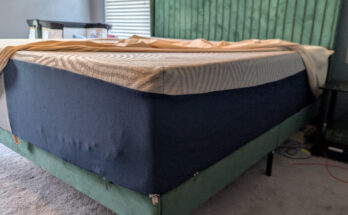Mistakes Everyone Makes When Using WD-40 Around The House
We may receive a commission on purchases made from links.
There are plenty of mistakes everyone makes when using WD-40 around the house. The substance has earned a permanent spot in many toolboxes for a good reason: It’s incredibly versatile. From silencing squeaky hinges to loosening stuck bolts, it’s the go-to solution for a wide range of household fixes. But, while it might seem like a miracle spray, WD-40 isn’t as foolproof as many people think. In fact, some of the most common uses around the house can actually be unsafe, ineffective, or even damaging when done the wrong way.
Whether it’s spraying it too close to an open flame, using it on the wrong materials, or ignoring other key safety precautions, these everyday mistakes are easy enough to make. Luckily, they are even easier to avoid once you know what to look out for. Just because something works once, this doesn’t mean it’s safe or smart to repeat. So before you reach for that familiar blue-and-yellow can, take a minute to make sure you’re using it properly. A few small adjustments can help you avoid costly damage, protect the health of everyone in your household, and make the most of this popular product. Here are some common mistakes homeowners make when using WD-40 in the house.
Using the flammable material near an open flame
WD-40 is incredibly useful, but it’s also highly flammable, so using it safely is very important. A mistake that some might make is to use the substance near something that might ignite it. Always keep it away from heat sources, open flames, or anything that could ignite vapors. That also means no smoking nearby, and be mindful of lit candles, gas stoves, or even space heaters or wax melts. For example, if you’re spraying WD-40 on a squeaky window and later light a candle on the sill, lingering vapors could ignite. You should avoid burning candles in these places where you’ve recently used the lubricant. Its vapors are heavier than air, so they stick around much longer than you think, especially in poorly ventilated areas. That makes even “small” sources of heat potentially dangerous.
Even when you are not using WD-40, a can of the substance can still be flammable, so store it properly. Never leave it somewhere that could get over 120°F, like a garage or shed with no airflow. Puncturing or burning the can may also cause it to explode.
Using the flammable material near any battery terminals
Traditional WD-40 may seem like a fix-all, but it is dangerous to use it near battery terminals or live electrical currents, like in the garage near your car. A spark can jump from a battery and ignite the flammable vapors, causing a sudden explosion. Pooled WD-40 can also ignite due to contact with a spark from a battery, so it’s best to keep the product out of your garage. It may be tempting to spray WD-40 on corroded car battery terminals to “clean them up,” but don’t. The heat or spark from a loose connection could ignite the vapors instantly. The same goes for household electrical panels. Resist the urge to lubricate circuit breaker hinges with WD-40.
Instead, use non-flammable electrical contact cleaners or dielectric grease designed specifically for battery and electrical maintenance, like the CRC 05103 QD Electronic Cleaner. When in doubt, read the label, follow manufacturer safety guidelines, or contact an expert like an automotive mechanic or electrician for advice.
Using it on certain plastics, which can damage them
Product instructions recommend using WD-40 Specialist Silicone Lubricant on worn-out plastics, particularly those impacted by bleaching from the sun, to help the materials regain their shine and maintain their color. However, this doesn’t mean that it’s a good idea to use WD-40 on all plastic. If the plastic in question is made from polyethylene, formica, epoxy, delrin, polypropylene, acrylic, vinyl, teflon, polyester, or nylon, then you shouldn’t have any issues. One study submerged samples of each of these plastics in the product for nearly two days, and there was no negative change to them.
What you need to be careful about is using WD-40 on a polycarbonate or a clear polystyrene plastic, common ingredients in window glazing, eyeglass lenses, many household electronics, 3D-printed objects, and some refrigerator components. The manufacturers of WD-40 also warn users to stay away from these materials when using something like WD-40 Specialist Dry Lube. The reason they don’t mix well is because one of the main ingredients in WD-40 is made from hydrocarbons. Hydrocarbons can sometimes react badly with certain soft plastics, causing them to break down or become weaker, which might make them soften or change shape. So even if the damage won’t be visible right away, it can wear them down and make them more prone to changing shape or stability.
Forgetting the right PPE for extended use
You might not think you need personal protective equipment (PPE) to use WD-40, but it’s a mistake for any new DIYer not to have it! For a quick spritz every now and again, most will be fine without any interventions. However, for extended use, even the manufacturer recommends taking a few precautions. The risks are as follows:
If you breathe in too much of the substance, you might begin to feel nauseous and dizzy. Severe reactions can even lead to respiratory infection. To prevent this, something you might even have around already — a KN95 face mask — can help you from breathing in too much of it. For some, getting the material on their hands or arms while using it can also cause a rash, or at the very least, a burning or itching sensation. To prevent this, consider wearing long sleeves and pants, as well as a pair of work gloves, which can be useful for many other chores around the home, too — any pro gardener knows that having the right gardening gloves is a lifesaver.
Allowing your pets access to the substance
Although it’s probably rare that your pet would swallow a cleaning liquid or similar harmful substance on purpose, there is a chance that you might unintentionally create a situation where it could happen. Before using WD-40 around pets, you need to know how it affects them and how to keep them safe. The exact contents of the material are a trade secret, but we do know that it contains petroleum. The Merck Veterinary Manual warns that the “ingestion or inhalation of, or skin contact with, petroleum, petroleum condensate … or other hydrocarbon mixtures may cause illness and occasionally death in domestic and wild animals.”
If you recently used WD-40 on a low door hinge, for example, your pet could become sick from licking it, or touching it and then licking their paw. Keep your pets away from any accessible spots where WD-40 has been used, until it is completely dry, and store the product in a safe, out-of-reach location. If they do ingest the product, take them to the vet right away.
Using traditional WD-40 on a squeaky bike chain
Do not use traditional WD-40 on a squeaky or stuck bike chain. Instead, there are specialized products from the company that work better for any problems you might be having, like rust, a hard time shifting gears, or an overall clunky ride. They are the WD-40 Specialist Bike Chain Lube or WD-40 Specialist Bike Degreaser. You might also notice that it comes in both wet and dry lube. Wet is for rainy or muddy rides, while dry is for dusty trails and roads. When picking a product, the important reason for the difference in their line of bike-specific options is that the traditional WD-40 works as both a lubricant and a water-displacing solvent, getting rid of any contaminants present. However, during this process, it also removes any lubricant you might have applied to the chain. That means that there could be even greater friction than before.
There is a great deal of controversy within the bicycling community over whether traditional WD-40 causes harm to bikes. Some say it is possible to use it effectively, as long as you apply a lubricant afterwards. Yet, other experts in the same field disagree, stating that purpose-made products are always going to be a better choice because there is less room for error.
Forgetting to clean the surface before using it
The classic WD-40 works best when it is applied to a clean, dry surface. Remember, WD-40 isn’t really a cleaner itself. Instead, it’s more of an oil that acts like a lubricant, plus a rust-prevention tool. Manufacturer’s guidelines insist that even in the most typical of cases (using it on a door hinge!), there needs to be no dirt or grime present. This is so the material can stick directly to the surface it’s trying to help, instead of fighting its way through a layer of dust. To clean things off, sometimes a dry cloth is all you will need. However, if the grime is really caked on, you might need to use a damp one to loosen things up. Just remember to pat the surface dry once you’re done scrubbing.
If you are dealing with dust that is built up in tight spaces, consider using compressed air to blast it out of the way before lubricating the joint. You can also use a toothbrush with extra-stiff bristles, like the DR PEFECT Extra Hard & Firm Toothbrush, to scrub out some of the harder-to-get bits of grime before you get to work.
Thinking that one type of WD-40 is a one-size-fits-all solution
While WD-40 typically refers to the combination lubricant and solvent originally developed in 1958, the company actually has a wide variety of WD-40 products with different uses for the home. Before you begin your next project, take a moment to consider the specific logistics of what you want to accomplish. The original material might not actually be what you need! While it still might temporarily resolve your issue, it might not permanently fix the problem, or prevent it from happening again. For this reason, it’s better to look for one of the WD-40 specialist products, just in case.
For example, if the rusted bolt you need to access isn’t easy to get to, then the WD-40 Specialist Penetrant with Flexible Straw is going to be more useful to you due to the shape of the product’s dispenser. If you are working with a hinge that is metal-on-metal, like on a driveway gate or exterior door, then WD-40 Specialist White Lithium Grease will better suit your needs because it has a different formula that is meant to not just decrease friction, but prevent more rust from forming in the future, too.



